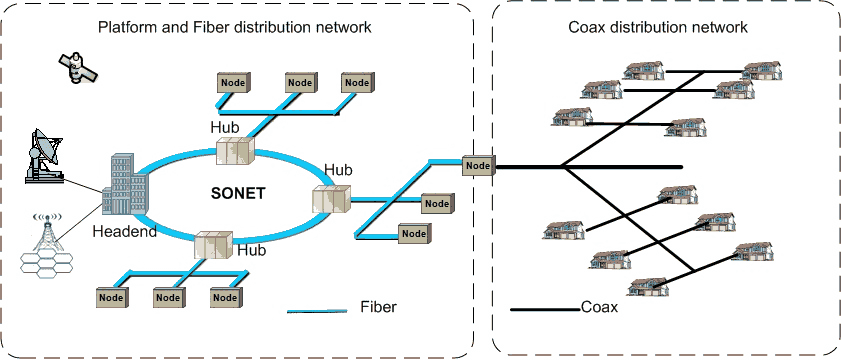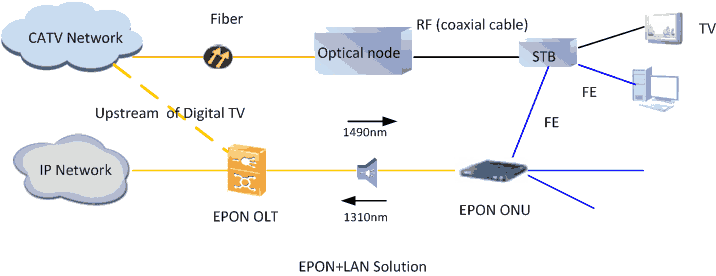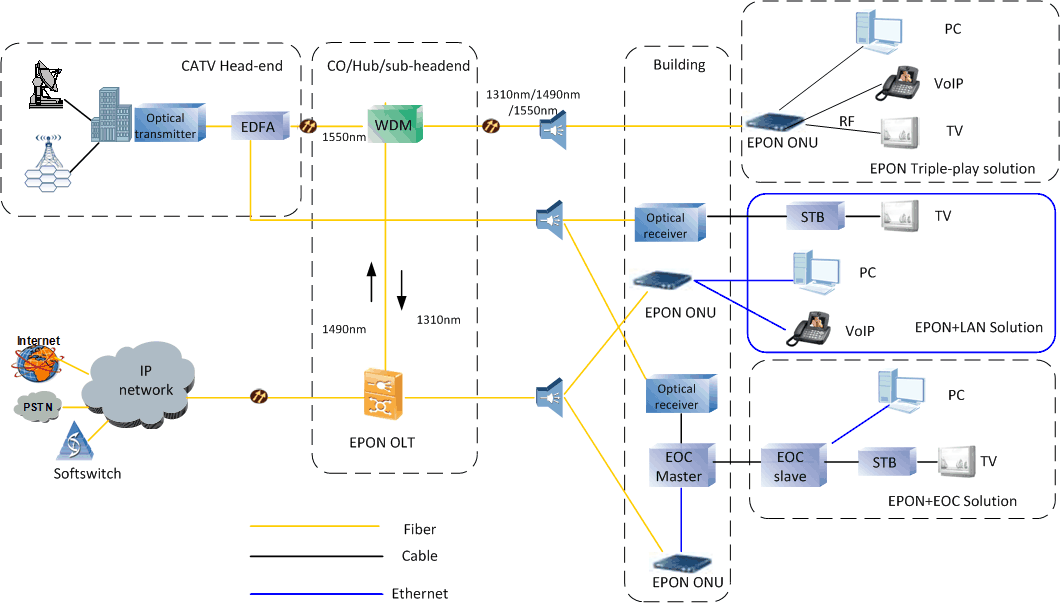With fiber technology being well adopted to the last mile access network to end users, cable network operator are fully aware of the rising threaten and are critical to seek an evolutionary solution with advance access network technologies for next generation cable access network.
The Challenges
The traditional cable network is limited in the coaxial cable’s capacity. Compare with coaxial cable,single-mode fiber optic cable in its standard 1310 and 1550 nm communications bands
has a theoretical physical capacity in excess of 10,000 GHz, and capacity can be allocated fully symmetrically between upstream and downstream. Fiber optics are not subject to outside signal interference, can carry signals for longer distances, and do not require amplifiers to boost signals in a metropolitan area broadband network.
This figure show a typical HFC structure. The various video sources are selected in the head-end. After processing, the signals are distributed over a high speed SONET /SDH to sub head-end or hubs which distribute to fiber node. The fiber nodes perform the optical-to-electrical conversion and begin the RF distribution over coaxial cable. Fiber feeder networks from hubs are typically star topology to localized nodes. Beyond the node location, a coaxial tree and branch topology is used to deliver the services to the home. Sub head-ends or hubs can serve a large number of business or residential communities.

HFC Evolution solution based on GEPON
Among current communications technologies,Gigabit Ethernet Passive Optical Network (GEPON) technology is a more competitive choice for MSOs to migration to lower-cost, all-digital video network when compared to approaches based on DOCSIS. The GEPON architecture consists of a series of unpowered passive optical splitters that are used to provide access to multiple premises over fiber optic cable alone, as opposed to a hybrid fiber/coax network. At the hub/sub-headend, both Ethernet and RF are combined via an Optical Line Terminal (OLT), which converts Ethernet and RF onto a single optical fiber that can service up to 64 ONUs. Voice, data, and IP video can be transmitted from the OLT to the subscriber at 1490nm. Data and IP video are transmitted from the subscriber’s ONT to OLT at 1310nm. In some case, a broadcast video overlay carried at 1550nm is added to the EPON using the same RF technology employed in cable TV networks. This 1550nm RF signal can carry analog channels, digital channels, or both.
Depend on the residential cabling , the GEPON solution can be different by EPON+LAN, EPON+EOC. It can reduce the initial investment and increase the speeds of operation and capabilities to offer advance service over the existing CATV coaxial network.
- EPON+LAN
The ONU devices are deployed at the optical nodes and the LAN access is added to support the interactive order and broadband access services such as internet, VoIP etc. The cable TV operator will still provide traditional DOCSIS and digital television service over the existing cable system. The interactive service such as video on demand (VOD) can be uplink to cable network via GEPON system.
In this solution, there is no requirement of modification or replacement of the existing cable system. It adopt dual cable (coaxial cable and Ethernet cable) to home users to offer broadband access to the traditional CATV users. A truly triple-play IP network is attained at lowest operational cost.

2. EPON+ Docsis EOC
The broadcast service such as analog TV and digital TV will be transmitted to optical receiver via catv system. The data ,voice service will be transmitted to ONU via EPON system. Optical receiver connect to DOCSIS EOC master with RF interface, and ONU connect to DOCSIS EOC master with Ethernet interface.
The DOCSIS EoC(Ethernet over coaxial) architecture utilizes the DOCSIS MAC/PHY layer technology and EPON network elements to implement an economical solution for utilizing DOCSIS CPE in China’s MDUs. At the MDU facility the EOC master provides the bridging function from EPON to the DOCSIS domain for Radio Frequency (RF) transmission over the coaxial risers in the building. The DOCSIS protocol is terminated at the subscriber location with standard off-the-shelf DOCSIS certified cable modems (CMs), Embedded Multimedia Terminal Adapters, (EMTA), or set-top boxes (STB) with embedded DOCSIS modems that utilize the DOCSIS Set-top Gateway protocol (DSG).
The approach will leverage existing EPON Optical Line Terminal (OLT) equipment to enable two-way services over cable at cost points competitive with proprietary EoC solutions, while providing speeds up to 400 Mbps.
This solution can make fully utilization the existing cable network and no requirement for the rewiring in the residential building. These benefits include multivendor interoperability, standardized and proven QoS for voice services, lowest cost, and wide availability of both cable modem and set-top box systems.
The main network elements are shown in DOCSIS EoC for EPON Network Architecture.

Solution Benefits
The bidirectional access network based on EPON technology set up a new combination of the interactive digital TV network and broadband network.

The advantage of EPON solution, relative to the current cable system, is that, once operational, it would allow a cable operator to virtually provide a dedicated IP Ethernet connection to each customer in a more efficient and direct way than using DOCSIS cable modems, and would allow cable operators and FTTP operators to be in the same marketplace for headend, hub and user premises equipment and take advantage of the economies of scale.
Telesail using its EPON technology can provide an excellent performance HFC access network which is totally different from traditional CATV system. Telesail EPON fully utilize or lease the existing cable TV network and IP metro network as ready-to-use-network at no additional construction cost. A truly Triple Pay over IP network is attained at lowest operational cost. The EPON system features standard, open architecture, intelligent management, is applicable to large scale, high dense surveillance with high requirement for image quality.
Today, cable operators offer EPON-based services for commercial customers with data rates up to symmetrical 10Gbps/10Gbps. EPON’s advantages include lower capital equipment costs, more stable and reliable technology, and products, and lower operational expenses.